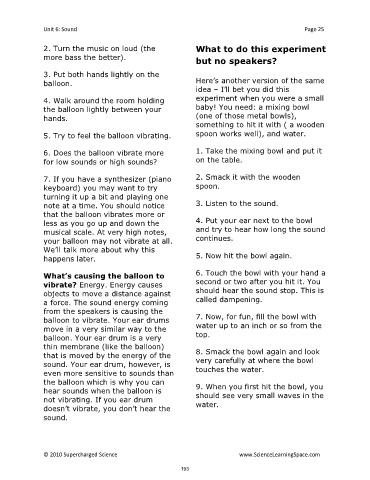Page 193 - Microsoft Word - LessonPlan-Overview.doc
P. 193
Unit 6: Sound Page 25
2. Turn the music on loud (the What to do this experiment
more bass the better).
but no speakers?
3. Put both hands lightly on the
Here’s another version of the same
balloon.
idea – I’ll bet you did this
4. Walk around the room holding experiment when you were a small
the balloon lightly between your baby! You need: a mixing bowl
(one of those metal bowls),
hands.
something to hit it with ( a wooden
5. Try to feel the balloon vibrating. spoon works well), and water.
6. Does the balloon vibrate more 1. Take the mixing bowl and put it
for low sounds or high sounds? on the table.
7. If you have a synthesizer (piano 2. Smack it with the wooden
keyboard) you may want to try spoon.
turning it up a bit and playing one
note at a time. You should notice 3. Listen to the sound.
that the balloon vibrates more or
4. Put your ear next to the bowl
less as you go up and down the
musical scale. At very high notes, and try to hear how long the sound
continues.
your balloon may not vibrate at all.
We’ll talk more about why this
5. Now hit the bowl again.
happens later.
What’s causing the balloon to 6. Touch the bowl with your hand a
vibrate? Energy. Energy causes second or two after you hit it. You
objects to move a distance against should hear the sound stop. This is
a force. The sound energy coming called dampening.
from the speakers is causing the
balloon to vibrate. Your ear drums 7. Now, for fun, fill the bowl with
move in a very similar way to the water up to an inch or so from the
top.
balloon. Your ear drum is a very
thin membrane (like the balloon)
that is moved by the energy of the 8. Smack the bowl again and look
sound. Your ear drum, however, is very carefully at where the bowl
even more sensitive to sounds than touches the water.
the balloon which is why you can 9. When you first hit the bowl, you
hear sounds when the balloon is
should see very small waves in the
not vibrating. If you ear drum
doesn’t vibrate, you don’t hear the water.
sound.
© 2010 Supercharged Science www.ScienceLearningSpace.com
193

